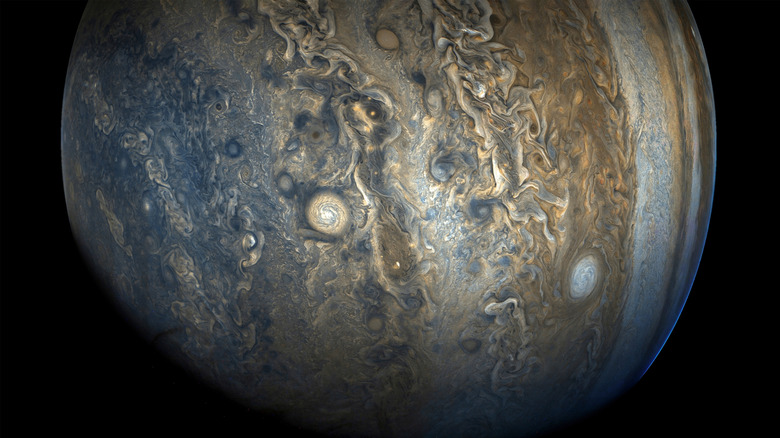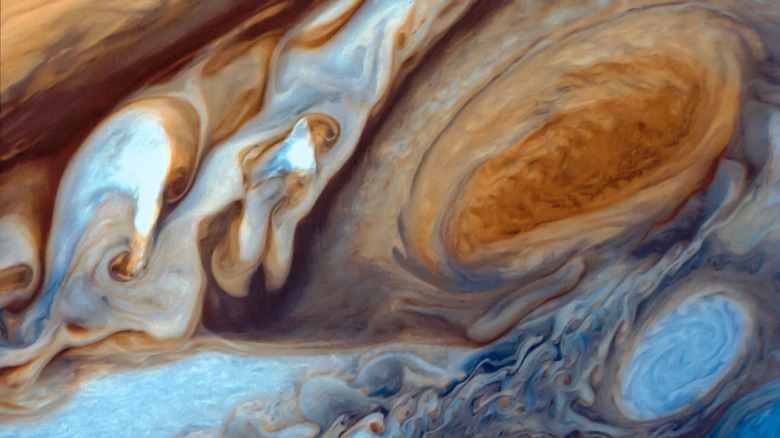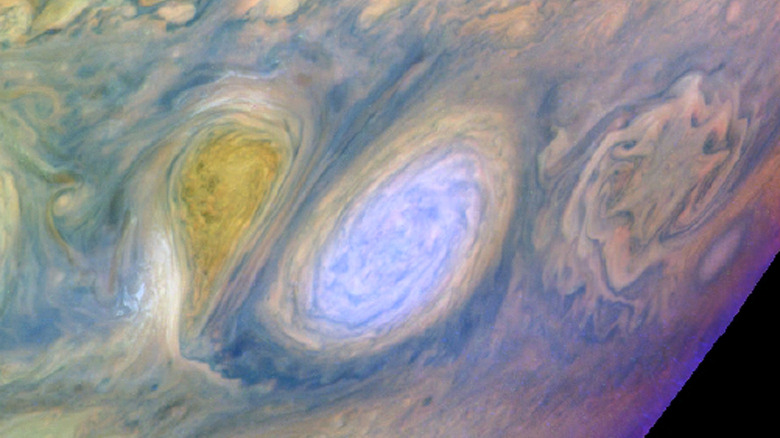The Largest Ocean In Our Solar System Isn't Made Of Water
Picture the most vast thing on the planet — the oceans. The numbers are tough to wrap our heads around: 139 million square miles of water at an average depth of roughly 12,000 feet (or just over two miles). Even trying to frame the largest body of water on Earth in a conceivable way is tough. In 2023, a man kayaked 2,300 miles from California to Hawaii, not even half of the distance across the Pacific Ocean. It took him 91 days.
And while that scale stretches the limits of what our brains can handle, it doesn't even come close to the largest ocean in the solar system — Jupiter's vast ocean of liquid hydrogen. On Earth, the element most commonly shows up as a chemical constituent of water, but under the right conditions, hydrogen gets downright weird, taking on the properties of a metal and even revealing its true quantum nature.
Jupiter holds our species' fascination for a number of reasons. It's incredibly far away (here's how long it would take to reach on our fastest crewed rocket). Its Great Red Spot is an Earth-sized storm that's been raging for centuries. It's got gorgeous, hexagonal-shaped weather systems at its poles, and its moon, Europa, is such a good candidate for finding oceans of liquid water beyond our own planet that we launched the Europa Clipper spacecraft in 2024 to travel 1.8 billion miles over the course of six years to find out if our theories are true. But just as compelling is the planet's vast ocean of hydrogen, and the more we learn about it, the more we understand just how strange and extreme the characteristics of Jupiter really are.
Jupiter's bizarre hydrogen ocean
Jupiter is composed largely of hydrogen and helium, not dissimilar from the sun. While both are enormous celestial bodies, the elements that exist on each behave very differently. The sun is essentially a super-hot sphere of ionized gas in the form of plasma. But on Jupiter, once you get far enough beneath its atmosphere, temperatures and pressures rise so much that hydrogen shifts into a supercritical fluid — a state that behaves both like a liquid and a gas.
If you go deeper still, even more bizarre things start to happen. It's thought that around halfway to Jupiter's center — some 8,000 miles beneath the clouds we see on the surface — the pressure becomes so immense that it breaks the bonds holding hydrogen's electrons to its atomic nuclei, resulting in a liquid that conducts electricity like a metal: liquid metallic hydrogen. And while hydrogen isn't a metallic element, these extreme conditions cause it to take on the properties of one (think of a melted-down bar of copper or titanium).
So, how big is this ocean of liquid metallic hydrogen? Scientists aren't exactly sure, but they believe this ocean starts about halfway down to the planet's core, meaning it could be tens of thousands of miles deep. To put that in perspective, if you wanted to drill to the center of the Earth from our planet's surface, you'd have to bore a hole just under 2,000 miles deep to get there, meaning Jupiter's liquid hydrogen ocean would engulf not only our oceans but our entire planet and its atmosphere several times over. Far from being a mere scientific curiosity, the gas giant's ocean — combined with the planet's super-fast rotation (a single day on Jupiter only lasts about 10 hours) is believed to drive the planet's powerful magnetic field.
Why Jupiter doesn't collapse on itself
The pressure at levels deep enough within Jupiter to turn hydrogen gas into a liquid metal is so great that scientists once thought such conditions were only present in neutron stars and white dwarves, some of the most extreme environments in physics. The very principle keeping those ultra-dense celestial bodies from collapsing in on themselves, despite the immense pressures they exhibit, is the same thing that allows Jupiter's liquid hydrogen ocean to support the thousands of miles of pressure bearing down above it — degeneracy pressure.
Degeneracy pressure is a phenomenon that emerges from the Pauli exclusion principle, which states that no two electrons can have the same energy level since it's impossible for them to inhabit the same quantum mechanical state. So, even if hydrogen's electromagnetic bonds are broken under the pressure of a planet like Jupiter (or a dying star), its component atomic parts can only be compressed so far before exhibiting a force that resists being squeezed any further. That force is the basis of the structural support that maintains Jupiter's metallic hydrogen layer.
So, the next time you're looking at an image of Jupiter's entrancing weather systems, just remember that what's hidden beneath those bands of brown, red, orange, white, and blue, is just as compelling and strange. And now that you know about some of the big ways in which the two planets are different, here are a few ways in which Jupiter and Earth are actually alike.


